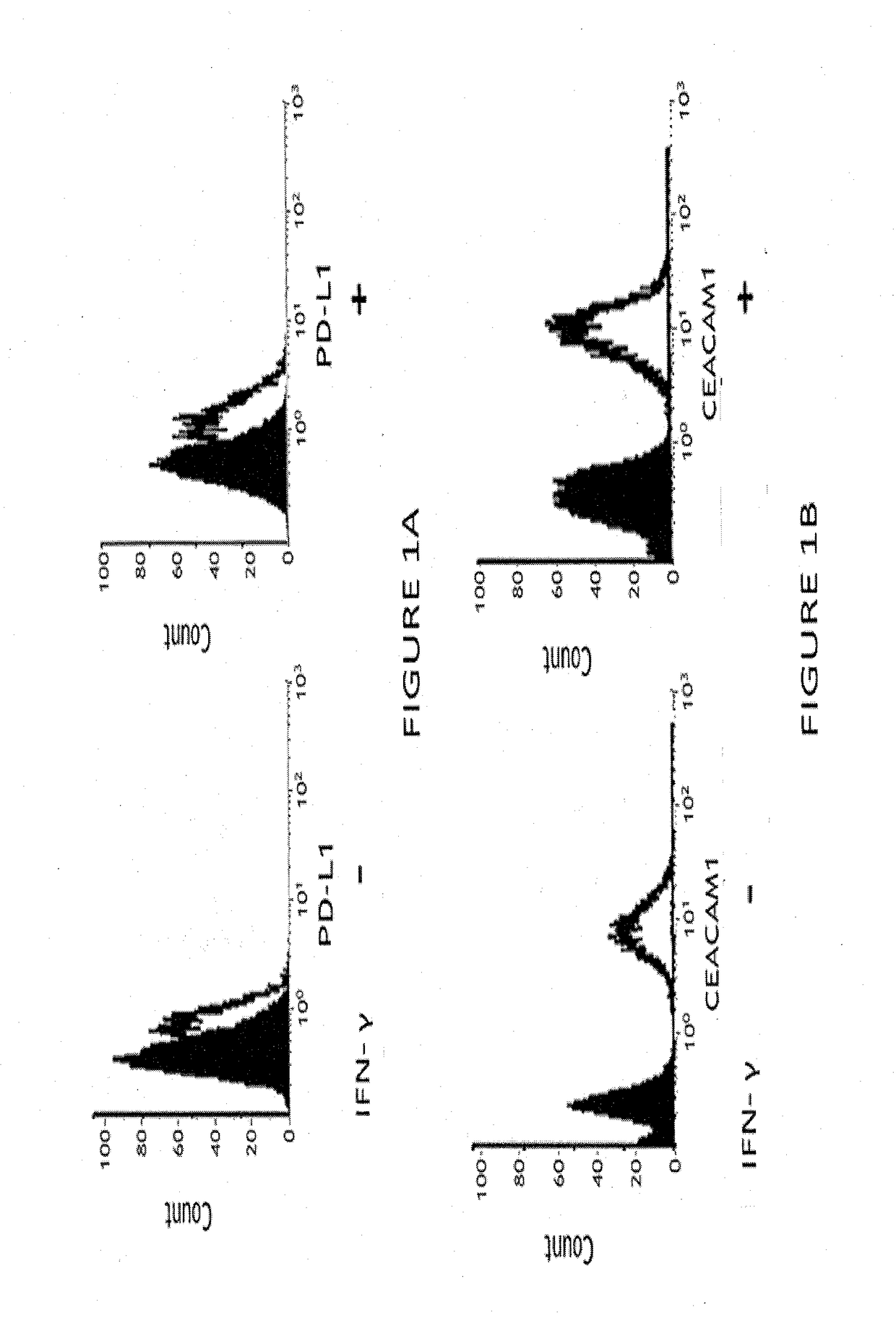Compositions comprising Anti-ceacam1 and Anti-pd antibodies for cancer therapy
a technology of anti-ceacam1 and anti-pdligand, which is applied in the field of cancer immunotherapy, can solve problems such as cell death, achieve the effects of improving clinical outcome, maximizing lymphocyte mediated cytotoxicity, and elevating the cytotoxicity of lymphocyte cells
- Summary
- Abstract
- Description
- Claims
- Application Information
AI Technical Summary
Benefits of technology
Problems solved by technology
Method used
Image
Examples
example 1
anoma Cells Express CEACAM1 and PD-L1 Upon IFN-γ Activation
[0164]Human melanoma cells (MALME 3M) were incubated with IFN-γ (2000 units / ml) for 24 hours, followed by FACS analysis with a PE-conjugated anti-PD-L1 antibody (clone 29E.2A3) or with PE-conjugated a monoclonal antibody to human CEACAM1 (CM-24, developed by cCAM Biotherapeutics). A similar assay was conducted for isotype control.
[0165]FIG. 1 demonstrates that human melanoma cells used in the experiments express both CEACAM1 and PD-L1.
example 2
Cells Express PD-1 and CEACAM1
[0166]Human TIL cells (tumor infiltrating lymphocytes expanded form patients #14 in Ella institute, Batch 14, TIL14,) were stained with a monoclonal antibody to human PD-1 (clone E12.2H7) or with a PE-conjugated a monoclonal antibody to human CEACAM1 (CM-24) followed by FACS analysis. The expression of PD-1 (A) and CEACAM1 (B) compared to a matching isotype control is presented.
[0167]FIG. 2 demonstrates that the human TIL cells used in the experiments express both PD-1 and CEACAM1.
example 3
ic Effects of Anti-CEACAM1 and Anti-PD-1 Antibodies on the Cytotoxicity of Human TIL Cells Against Human Melanoma Cells
[0168]Human melanoma cancer cells (MALME 3M) were grown in the presence of IFN-γ to induce PD-L1 expression. Human TIL cells (TIL14) were incubated with a monoclonal antibody to human CEACAM1 (CM-24) (0.01 μg / ml, 0.05 μg / ml, 0.1 μg / ml, 0.5 μg / ml), a monoclonal antibody to human PD-1 (clone E12.2H7) or with a combination of both antibodies (0.005, 0.025, 0.05 and 0.25 μg / ml of each antibody) for 30 minutes at 37° C.
[0169]IFN-γ-treated human melanoma cancer cells were added for overnight incubation, prior to cytotoxicity evaluation (FIG. 3). Results represent an average of % cytotoxicity ±SE as determined by classical LDH release assay from triplicate wells per treatment. *P<0.05 paired T-test compared to CM-24 only. The combination index (CI) was calculated to be ≦0.2, according to the following equation:
CI=(D)1(Dx)1+(D)2(Dx)2<1→synergism
FIG. 3 demonstrates that b...
PUM
| Property | Measurement | Unit |
|---|---|---|
| volume | aaaaa | aaaaa |
| affinity | aaaaa | aaaaa |
| concentrations | aaaaa | aaaaa |
Abstract
Description
Claims
Application Information
 Login to view more
Login to view more - R&D Engineer
- R&D Manager
- IP Professional
- Industry Leading Data Capabilities
- Powerful AI technology
- Patent DNA Extraction
Browse by: Latest US Patents, China's latest patents, Technical Efficacy Thesaurus, Application Domain, Technology Topic.
© 2024 PatSnap. All rights reserved.Legal|Privacy policy|Modern Slavery Act Transparency Statement|Sitemap



